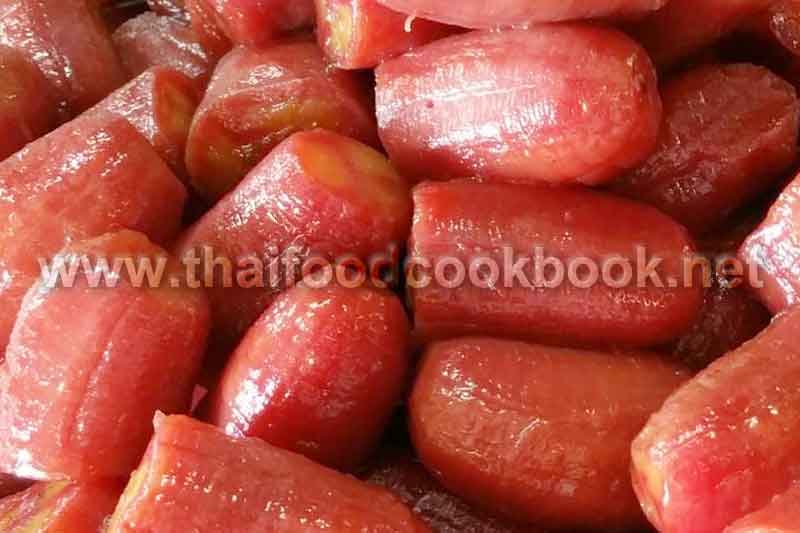Thai Doughnuts – Pa Tong Go (pa-tong-go) – A Complete Guide to Making Crispy and Fluffy Thai Fried Dough
Many home cooks attempt to make Thai Doughnuts – Pa Tong Go (pa-tong-go) but often end up with dough that is too dense, overly oily, or fails to puff up properly in the hot oil. These challenges usually come from incorrect dough hydration, improper resting time, or oil temperatures that fluctuate during frying. To help everyone recreate the perfectly airy and crispy Thai doughnuts seen in morning street markets across Thailand, this guide provides clear instructions, practical tips, and a reliable recipe. You can explore more authentic Thai breakfast recipes at Thai Food Cookbook for additional inspiration.
In this article, you will learn how to prepare Thai Doughnuts – Pa Tong Go (pa-tong-go) step-by-step, including how to mix and rest the dough, shape the signature double-stick form, and fry it to golden perfection. Natural key phrases such as Thai fried dough recipe, traditional Pa Tong Go method, crispy Thai doughnut technique, and street-style Thai breakfast dough are included throughout the content to ensure readers easily find and understand every part of this guide. This comprehensive explanation helps solve common frying issues while teaching the techniques needed to achieve authentic Pa Tong Go at home.
Authentic Thai Doughnut Recipe for Perfect Pa Tong Go at Home
Thai Doughnuts – Pa Tong Go (pa-tong-go) are a staple in Thai morning markets, typically enjoyed with warm soy milk or Thai-style pandan custard. Known for their light, airy texture and crispy exterior, they are made using a simple dough that relies on proper fermentation and high-heat frying. Getting the texture right requires careful attention to the dough’s moisture level, resting time, and shaping technique.
The dish is popular not only because of its flavor but also because of its versatility. Many enjoy Pa Tong Go dipped in sweetened condensed milk, pandan cream, or even as a side with congee. This makes it a classic Thai breakfast item beloved across all generations.
Ingredients for Thai Doughnuts – What You Need for Crispy Pa Tong Go
Prepare the following ingredients for an authentic batch of Thai fried dough:
- 2 cups all-purpose flour
- 1 tsp baking powder
- 1/2 tsp baking soda
- 1 tsp sugar
- 1/2 tsp salt
- 3/4 cup water (adjust as needed for dough consistency)
- 1 tbsp vegetable oil
- Oil for deep frying
- Optional: pandan custard or sweetened condensed milk for dipping
Using the correct ratio of baking powder and baking soda helps the dough expand quickly when fried. Hydration is equally important—slightly sticky dough gives Pa Tong Go its signature airy crumb.
How to Make Thai Doughnuts – Step-by-Step Method for Light and Crispy Pa Tong Go
Follow this detailed method to achieve perfect results:
- In a bowl, mix flour, baking powder, baking soda, sugar, and salt.
- Add water gradually while mixing until the dough becomes slightly sticky.
- Add vegetable oil and knead gently until the dough is smooth.
- Cover and let the dough rest for at least 2–3 hours to allow rising.
- Dust a surface with flour and stretch the dough into a flat rectangle.
- Cut into long strips, then pair two strips together by lightly pressing them to form the traditional double-stick shape.
- Heat oil to 180°C (356°F). Test by dropping a small dough piece; it should rise and bubble immediately.
- Fry Pa Tong Go pieces until golden brown, flipping occasionally for even cooking.
- Drain excess oil and serve warm with pandan custard or sweetened condensed milk.
To explore more about the cultural background and variations of this morning street food, you can check additional information at Pa Tong Go Overview, which highlights its history and regional adaptations.
Techniques for Achieving Crispy and Airy Thai Doughnuts Every Time
Perfecting Thai Doughnuts – Pa Tong Go (pa-tong-go) requires understanding essential frying principles. Maintaining the correct oil temperature is crucial; too cold and the dough absorbs oil, too hot and it browns too quickly without fully puffing. Ensuring the dough is rested sufficiently helps develop gluten and enhances elasticity, allowing the doughnuts to expand beautifully in hot oil.
- Use a thermometer to keep oil between 170–185°C (338–365°F).
- Allow dough to rest long enough to develop air bubbles.
- Do not over-knead; a slightly sticky dough is ideal.
- Always fry in small batches to maintain oil temperature.
- Serve immediately for the best crispiness.
Why Thai Doughnuts – Pa Tong Go Remain a Timeless Thai Breakfast Favorite
Pa Tong Go continues to be a beloved Thai breakfast treat because of its simple ingredients, unique shape, and delicious taste. Its crisp exterior and fluffy interior create a satisfying contrast that pairs perfectly with both sweet and savory accompaniments. For many families, buying Pa Tong Go from local vendors is a cherished morning ritual.
As more people around the world discover Thai cuisine, Thai Doughnuts – Pa Tong Go (pa-tong-go) have become increasingly popular thanks to their simplicity and delightful flavor. This recipe enables anyone to enjoy authentic Thai street-style doughnuts at home with ease.
Summary: How to Make Authentic Thai Doughnuts – Pa Tong Go
This guide provides everything needed to prepare Thai Doughnuts – Pa Tong Go (pa-tong-go), from selecting ingredients and mixing the dough to shaping and frying the traditional double-stick form. With clear steps, essential tips, and expert techniques, you can achieve crispy, airy, and delicious Pa Tong Go that captures the true flavor of Thailand’s iconic street breakfast.

